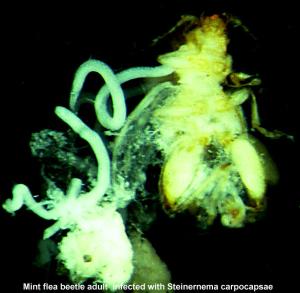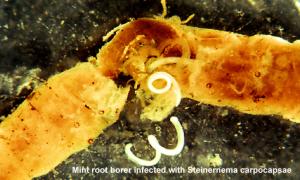Contents
Identification
Fact
Sheet (requires Acrobat Reader 3.x or
above to read and print. Click below to download the free "Reader".)

Registered
Insecticides
References
[Insect
Management]
[Home] |
|
 |
 |
| Parasitic Nematode on
Mint Flea Beetle |
Parasitic Nematode on
Mint Root Borer |
 |
Infection of insect hosts by parasitic
nematodes is initiated by the free-living third-stage infective juveniles (IJs). Nematodes
enter the host through natural openings, such as the mouth, anus, and spiracles. Once
inside their host, IJs release their symbiotic bacteria, which kills the insect within 48
hrs. The bacteria, which multiply in the insect host, are consumed and digested by the
developing nematodes. Nematodes complete development to the adult stage inside the insect
host. Females lay eggs in the dead insect that hatch and develop into the IJs that escape
into the soil from their dead insect host. Parasitic nematodes have several important
attributes that make them excellent candidates for biological control of soil insects.
Numerous insect pests on many different crops are controlled by parasitic nematodes,
including root weevils, mint flea beetle, mint root borer and other species of borers,
white grubs, and caterpillars. (see Takeyasu 1994) |
Parasitic Nematode on
Strawberry Root Weevil |
View the Fact
Sheet for More Information |
This section contains information on the
use of parasitic nematodes. The Fact
Sheet contains specific information on the biology of some of the most
common species of nematode parasites (requires Acrobat Reader).
|



